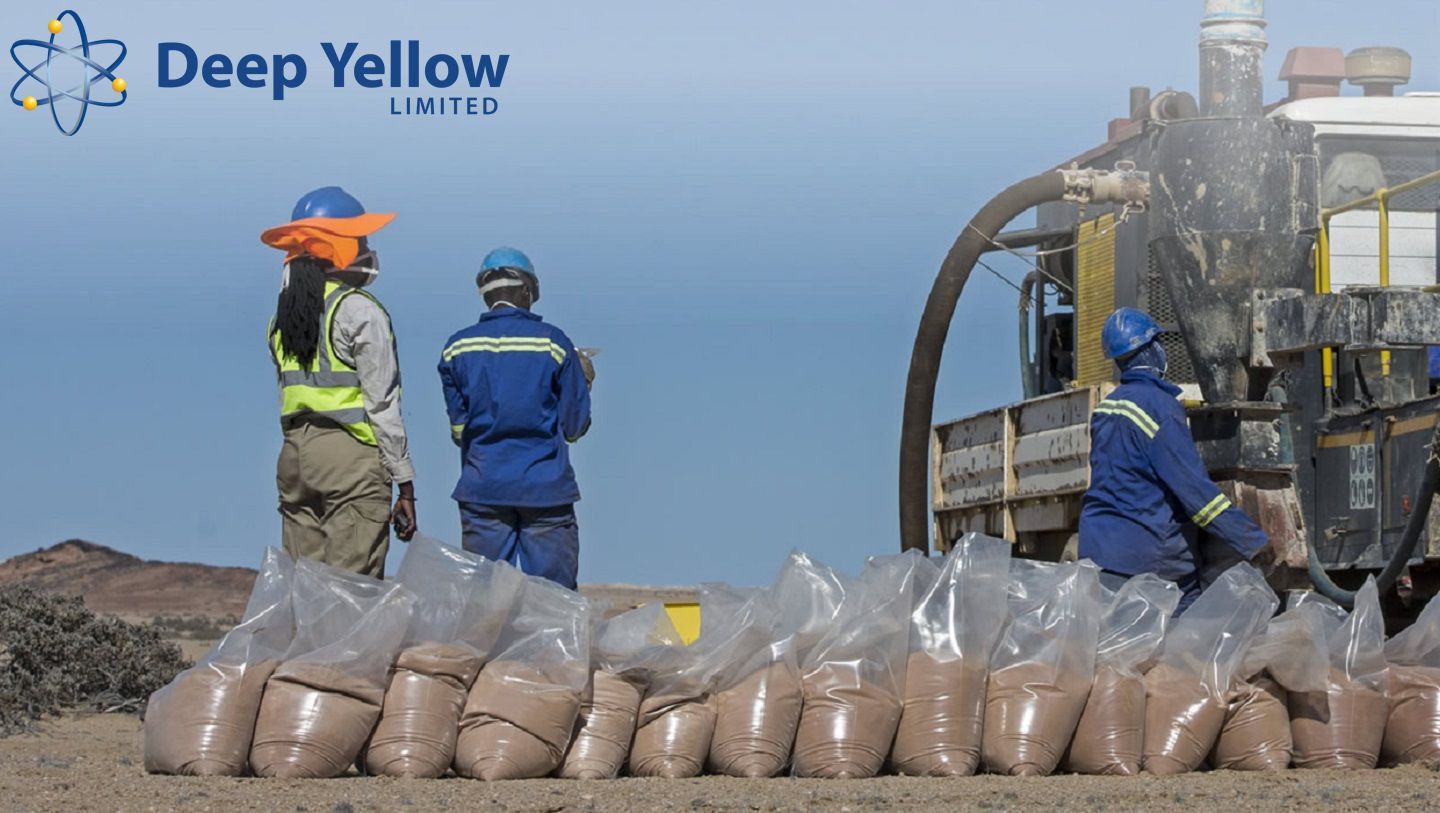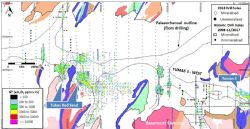
Tumas Palaeochannel Drilling Returning Positive Results
Perth, April 17, 2018 AEST (ABN Newswire) - Deep Yellow Limited ( ASX:DYL) (
ASX:DYL) ( DYLLF:OTCMKTS) (Deep Yellow) is pleased to report continued encouraging drilling results from the ongoing semi-regional exploration and Tumas 3 East resource drilling program which is being carried out on EPL3496. This EPL is held by Deep Yellow's wholly-owned subsidiary, Reptile Uranium Namibia (Pty) Ltd (RUN).
DYLLF:OTCMKTS) (Deep Yellow) is pleased to report continued encouraging drilling results from the ongoing semi-regional exploration and Tumas 3 East resource drilling program which is being carried out on EPL3496. This EPL is held by Deep Yellow's wholly-owned subsidiary, Reptile Uranium Namibia (Pty) Ltd (RUN).
Highlights
- Semi-regional drilling campaign - 89 holes drilled for 3984m west of Tumas 3 deposit
o 22 holes identified uranium mineralisation with one area earmarked for follow-up drilling
- Tumas 3 East extension resource drilling commenced with 84 holes drilled for 1,939m
o Resource drilling success rate of 60% with 50 out of the 84 holes returning mineralisation >100ppm eU3O8 over 1m
- Strongest intersections from the resource drilling include:
o TB3R543 6m at 346 ppm eU3O8 from 4m
o TB3R569 7m at 413 ppm eU3O8 from 6m
o TB3R593 8m at 733 ppm eU3O8 from 3m
- Mineralisation is calcrete associated hosted within palaeochannels, similar to the Langer Heinrich uranium mine located 30km to the north east
As reported previously, the programs commenced 12 February 2018 with semi-regional exploration drilling to the west of Tumas 3. Phase 1 of this regional program was completed on 21 March with 89 RC holes drilled for 3,984m. This was immediately followed by resource drilling east of the Tumas 3 uranium deposit with 84 RC holes drilled for 1939m and work is ongoing. The balance of the 10,000m campaign remaining to be drilled in the period to 30 June 2018 is continuing and will focus on resource drilling over the Tumas 3 east and Tumas 1 & 2 extension areas plus further semi-regional exploration drilling. Figure 1 (see link below) shows the palaeochannel system and prospect locations.
Resource Drilling
The resource drilling east of the Tumas 3 deposit targeted the mineralised zone which was broadly delineated during the November 2017 drilling program. The latest drilling has confirmed existence of the predicted continuous uranium mineralisation extending over 2km in length. Of the total 84 holes drilled, 50 returned positive results - an overall 60% success rate. Equivalent uranium oxide (eU3O8) values as reported herein have been determined by Deep Yellow personnel and these will be validated for resource estimation purposes. The equivalent uranium values are based on down-hole radiometric gamma logging carried out by a fully calibrated Aus-Log gamma logging system.
This infill work showed uranium mineralisation occurring on all the new profiles drilled with 50 of 84 holes returning positive results. Figure 2 (see link below) shows the resource drill hole locations in relation to the Tumas 3 deposit. The width of the mineralisation varies between 200 and 400m with variable thicknesses of 1 to 8 m. The mineralisation remains open to the east and south. Figure 3 (see link below) shows a drill-hole cross section across the Tumas 3 eastern extension and outlines the continuous nature of the uranium mineralisation and also the variability and complexity of the palaeochannel topography.
The infill drilling in this area is continuing and will also include testing of the tributary channel identified from the November 2017 drilling.
Mineralised intersections from the resource drilling that are above the 100ppm eU3O8 over 1m cut-off are tabulated in Table 1, Appendix 1 (see link below).
Semi-Regional Exploration Drilling
The semi-regional exploration drilling has now explored approximately 20 km of the palaeochannel system that extends west from the Tumas 3 deposit. Drill hole spacing chosen was highly variable ranging from 100 to 200m spaced holes along profiles 400 to 800m apart. The drill hole spacing was aimed at identifying new uranium mineralisation within the untested portion of palaeochannel system where 3 of the previously defined 7 semi-regional target zones exist. Due to access clearance issues (now resolved) the central part of this zone could not be explored in the current program and this will now be tested later in the year. Elsewhere the drilling did however identify promising uranium mineralisation in a tributary to the main channel located approximately 3km north of the Tubas Red Sand deposit. This drilling identified 3 to 8m thick > 100ppm eU3O8 uranium mineralisation over a 200 to 300m width on 2 drill sections 400m apart. Figure 4 (see link below) shows the exploration drill hole locations and the palaeochannel outlines west of the Tumas 3 deposit.
In total 22 (or 25%) of the 89 exploratory drill holes returned uranium mineralisation > 100 ppm eU3O8 over 1m. It should however be noted lower grade uranium mineralisation was identified in a large proportion of the semi-regional drilling supporting management's proposition that a large-scale uranium mineralisation event has occurred throughout the palaeochannel system where tested.
Mineralised intersections from the semi-regional exploration drilling >100ppm eU3O8 over 1m cut-off are tabulated in Table 2, Appendix 1 (see link below). Figure 4 (see link below) also shows the semi-regional exploration drill hole locations. All drill hole locations are listed in Table 3, Appendix 1 (see link below).
Analysis
The results of both the semi-regional exploration and targeted resource drilling are very encouraging. The drilling has confirmed the continuous nature of mineralisation associated with the eastern extension of Tumas 3 and importantly has identified new uranium mineralisation in the palaeochannel system to the west of this zone.
The 2018 drill program which is still ongoing has extended the mineralisation at Tumas 3 by 2km and is demonstrating that the mineralisation has the potential to extend over a +7km strike length in the Tumas 3 area. Also, additional mineralisation is expected to be found in a tributary entering the main channel from the east. As previously shown, the uranium mineralisation is not confined to one simple, single channel but rather is associated with a complex palaeodrainage system containing several channels that head westward toward the ocean. The current results again show that, apart from the benefit gained by the reinterpretation of the existing airborne geophysical data to locate the prospective palaeochannel systems more accurately, discovery is only possible by drilling.
Appendix 1 Tables 1 and 2 (see link below) list the 50 resource drilling holes and 22 semi-regional exploration drill holes returning uranium intersections above cut-off and showing equivalent uranium values in ppm and thickness with hole depth and coordinates provided. Table 3 in Appendix 1 (see link below) lists all drill holes completed to 14 April 2018 from the current drilling program which are the subject of this release.
Conclusion
This third (ongoing) drilling campaign is again producing successful results. It is confirming that the previously discovered Tumas 3 deposit can be expanded. This is not only expected to add to the current uranium resource base of this project but, just as significantly, emphasises the strong exploration potential of the extensive, uranium-fertile palaeochannel system within which the new Tumas 3 discovery occurs.
There are now 4 distinct mineralised zones (Tumas 1 & 2, Tumas 3 and Tubas Sand/calcrete deposits) identified within the 125km of palaeochannels that occur within the Reptile project tenements (see figure 1 in link below). Some 75%, or approximately 90 km, of this palaeochannel system which deepens to the west remains to be properly tested.
These positive results both from the current and 2017 drilling and reinterpretation of historic exploration data confirm management's confidence that the existing uranium resource base for Langer Heinrich style deposit/s within the Reptile project area can be further increased.
The current drilling program will continue throughout 2018 with infill resource drilling required for resource estimations as well as to semi-regionally explore the extensive palaeochannel system that exists.
An updated inferred resource estimation for the Tumas 3 Zone is expected to be delivered in July 2018.
To view figures and Appendix, please visit:
http://abnnewswire.net/lnk/U928H9Y0
About Deep Yellow Limited
 Deep Yellow Limited (ASX:DYL) (OTCMKTS:DYLLF) is successfully progressing a dual-pillar growth strategy to establish a globally diversified, Tier-1 uranium company to produce 10+Mlb p.a.
Deep Yellow Limited (ASX:DYL) (OTCMKTS:DYLLF) is successfully progressing a dual-pillar growth strategy to establish a globally diversified, Tier-1 uranium company to produce 10+Mlb p.a.
The Company's portfolio contains the largest uranium resource base of any ASX-listed company and its projects provide geographic and development diversity. Deep Yellow is the only ASX company with two advanced projects - flagship Tumas, Namibia (Final Investment Decision expected in 1H/CY24) and MRP, Western Australia (advancing through revised DFS), both located in Tier-1 uranium jurisdictions.
Deep Yellow is well-positioned for further growth through development of its highly prospective exploration portfolio - ARP, Northern Territory and Omahola, Namibia with ongoing M&A focused on high-quality assets should opportunities arise that best fit the Company's strategy.
Led by a best-in-class team, who are proven uranium mine builders and operators, the Company is advancing its growth strategy at a time when the need for nuclear energy is becoming the only viable option in the mid-to-long term to provide baseload power supply and achieve zero emission targets.
Importantly, Deep Yellow is on track to becoming a reliable and long-term uranium producer, able to provide production optionality, security of supply and geographic diversity.
| ||
|








